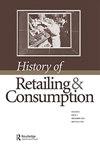Selling Swedish summer: the marketing of Pommac, 1920–1960
Q2 Arts and Humanities
引用次数: 0
Abstract
ABSTRACT This paper offers the first case study of the Swedish soft drink Pommac, launched in 1919, and how the brand established itself as the ‘taste of summer’. Using multimodal critical discourse analysis to examine a large dataset of Pommac advertisements, it traces the brand's development over its first forty years on the market (1920–1960), identifying the ways in which summer was depicted in advertisements, how this shifted over time in accordance with changes in Swedish society and how this worked in tandem with other secondary themes, such as luxury, sophistication and alcohol substitution. It finds that the concept of summer that Pommac initially promoted was highly idealised and oriented towards a middle-class public. In the 1940s, Pommac began to include working-class audiences in its advertisements for the first time, thereby creating a segmented market for the drink based around each group's supposed tastes, cultures and forms of socialisation. Ultimately, the paper demonstrates how leisure has long been exploited by brands to engage with specific target audiences and enhances our understanding of class-based approaches to lifestyle marketing, while also showcasing some uniquely Swedish marketing characteristics that emerged in response to particular social, cultural and political developments in the country.销售瑞典夏季:Pommac的营销,1920–1960
摘要本文以1919年推出的瑞典软饮料Pommac为例,介绍了该品牌如何成为“夏日的味道”。使用多模态批判性话语分析来检查Pommac广告的大型数据集,它追溯了该品牌在市场上的前四十年(1920–1960)的发展,确定了广告中对夏天的描述方式,这是如何随着时间的推移而随着瑞典社会的变化而变化的,以及这是如何与其他次要主题协同工作的,例如奢华、精致和酒精替代。研究发现,Pommac最初推广的夏季概念是高度理想化的,面向中产阶级公众。20世纪40年代,Pommac首次开始在广告中包括工薪阶层观众,从而围绕每个群体的所谓口味、文化和社交形式,为这种饮料创造了一个细分市场。最终,本文展示了品牌如何长期利用休闲来吸引特定的目标受众,并增强了我们对基于阶级的生活方式营销方法的理解,同时也展示了瑞典在应对特定社会、文化和政治发展时出现的一些独特的营销特征。
本文章由计算机程序翻译,如有差异,请以英文原文为准。
求助全文
约1分钟内获得全文
求助全文
来源期刊

History of Retailing and Consumption
Arts and Humanities-History
CiteScore
0.50
自引率
0.00%
发文量
3
 求助内容:
求助内容: 应助结果提醒方式:
应助结果提醒方式:


